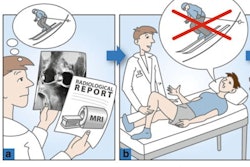
During an age when machines and artificial intelligence (AI) are playing an increasing role, radiologists must become more visible to safeguard patients' perception of them as physicians and as human beings, according to Swiss-led research. This involves setting aside time for direct communication with patients.
A new study, published online by European Radiology (25 June 2018), has shown that patients appreciate speaking with radiologists, even for a couple of minutes immediately after examinations, because it improves their sense of the patient-doctor relationship, result transparency, and departmental competence.
 Dr. Andreas Gutzeit from Lucerne, Switzerland.
Dr. Andreas Gutzeit from Lucerne, Switzerland.The research was a collaboration between a team from Hirslanden St. Anna Clinic in Lucerne and a group from the Friedemann Schulz von Thun Institute for Communication in Hamburg, Germany. The researchers have shown how talking to patients, even briefly, can improve both their sense of well-being and their confidence in the radiology department, explained lead author Dr. Andreas Gutzeit, a general radiologist at the Hirslanden Clinic who also has a degree in communication psychology.
As a medical student, Gutzeit waited five weeks for an "all clear" after undergoing an MRI exam to diagnose the root of painful headaches. The experience made him realize that bonding and communication with doctors made all the difference to a radiology patient's experience and also patients' overall view of the profession.
Anxious patients
"Most of the time patients walk out of a radiology exam feeling stressed about the results and not knowing anything about their diagnosis. In our study, those who consulted with the radiologist after the exam reported that this interaction was an important aspect in a good radiology service," Gutzeit told AuntMinnieEurope.com. "The study was so successful in showing how communication impacts on patients' psychological well-being that future patient communication projects involving other disciplines are now under discussion."
The study took place between January and June 2017 and involved 298 independently mobile outpatients who were randomized into one of two groups: 123 patients to group 1 (n = 101, after return of questionnaire) and 175 patients to group 2 (n = 101, after return of questionnaire).
After routine MRI, patients in group 1 were given the opportunity to discuss the findings with the radiologist. Patients in group 2 left the radiology department without any personal communication. Subsequently, patients answered a questionnaire designed by an expert psychologist about their anxiety, emotional attachment to the institute, and subjective assessment of competence.
The key findings are shown in the following table:
| Summary of results from the patient questionnaire following MRI | |||
| Group 1 with consultation (n = 101) |
Group 2 without consultation (n = 101) |
p-value | |
| Favored department | 0.001 | ||
| Based on my experience, I would no longer like to be in this radiology department and will inform my general practitioner (GP)/referring physician. | 0 (0.0%) | 1 (1.0%) | |
| I only want to go to this institute of radiology for future radiological investigations and will inform my GP/referring physician. | 94 (93.1%) | 76 (75.2%) | |
| I do not mind which radiology department my GP/referring physician sends me to. | 7 (6.9%) | 24 (23.8%) | |
| A final discussion with radiologist after an MRI examination is an important part of medical service. | < 0.001 | ||
| Yes | 82 (81.2%) | 14 (13.9%) | |
| No | 19 (18.8%) | 87 (86.1%) | |
| Mean score for competence of radiology department (5-point scale) | 4.7 (± 0.5) | 4.1 (± 1.0)* | < 0.001 |
There were no statistical differences between the groups in terms of age and gender. The same radiologist was present for all MRI exams across each group. Consultations with patients in group 1 averaged 3 minutes 47 seconds. A total of 23 patients in group 1 were excluded due to failure to return the questionnaire, while 74 patients in group 2 were excluded for the same reason.
The questionnaire included questions about the patients' subjective stress or anxiety levels, with responses categorized as the following: I don't think about it, no stress, very little stress, medium stress, and massive stress. Patients also rated the subjective importance of direct communication with the radiologist as either an "important" or "unimportant" part of the service.
Patients rated perception of competence on a five-point scale, with 1 indicating the lowest competence and 5 the indicating highest competence, while patients answered bonding questions on a three-point scale that included the following: no longer wishing to consult the institute's radiology department for future exams, wishing to consult only this institute's radiology department for future exams, and not caring which radiology department they consulted. Finally, patients indicated their concern about radiology findings as follows:
- Indifferent to the result
- Interested in the result but not stressed
- Worried about the result
- Excessively worried about the result
| Summary of the patients' concerns | |||
| Worries about result | Group 1 with consultation (n = 101) |
Group 2 without consultation (n = 101) |
p-value |
| I excessively worry about results. | 26 (25.7%) | 22 (21.8%) | 0.179 |
| Yes, I worry about results. | 51 (50.5) | 55 (54.5) | |
| Interested in the result but not stressed. | 19 (18.8%) | 12 (11.9%) | |
| Indifferent to the results. | 5 (5.0%) | 12 (11.9%) | |
The researchers found no significant difference between the two groups (p = 0.179) regarding stress levels concerning the radiology findings. Overall, 76 % of all patients were worried or excessively worried about radiology findings
Beneficial exchange
Overall, 76% of all patients were concerned about their imaging findings without significant difference between either group (p = 0.179). Significantly more patients in group 1 (81%) versus group 2 (14%; p < 0.001) perceived the opportunity to discuss their imaging findings with a radiologist to be a characteristic of a good radiology consultation.
A larger number of patients in group 1 (93%) experienced significantly higher bonding than in group 2 (75%) and only wanted in the future to be examined in the department with communication (p = 0.001). Significantly more patients in group 1 regarded the radiology department they attended as being more competent (mean score 4.72 versus 4.09 in group 2, p < 0.001).
While the study findings revealed important differences between both groups of patients, it is difficult to change overall patient management in busy departments when the priority remains making accurate and speedy reports, and communication with patients is secondary, according to Gutzeit. While consultations with patients from group 1 averaged 3 minutes, other patients took longer, and this could be problematic in a busy department, he noted.
"I try to make time to communicate with as many cross-sectional imaging patients as possible. For these more complex cases, direct communication is often beneficial for the patient and can help fill in any gaps in history to help in the diagnostic process," Gutzeit stated. "If there is suspicion of malignancy or the need for further examinations or biopsy, I aim to give the information to the patient directly after the exam. Even in cases of possible malignancy, patients seem happy about these aspects of transparency and explanation."
He believes that with the advent of AI and machine learning, radiologists are increasingly losing visibility and, thus, lobbying power with patients and other specialties.
"When our own behavior is machine-like, nobody will mind when machines replace us," Gutzeit noted. "But patients want to be diagnosed by humans. Departmental projects that encourage conversation between practitioner and patient hopefully will improve the professional's profile and highlight how central imaging and the imager are to the diagnostic process."
Furthermore, this type of empathy should be the cornerstone of all disciplines, the study authors stated. Gutzeit and colleagues are currently in discussion with the Friedemann Schulz von Thun Institute for Communication about the possibility of training nurses and doctors in patient communication techniques, and they have co-authored a book by R. Heiland and colleagues titled Communication for Physicians, which is to be released this summer.
"Radiologists should be aware that nearly 80% of patients in the study were worried about their imaging results, and this is probably representative of other institutions. Workloads are tough, but hospitals can change management processes to allow some patients to benefit from consultation, boosting their confidence in -- and affinity with -- the service," Gutzeit added.



















